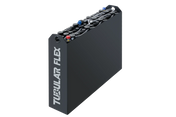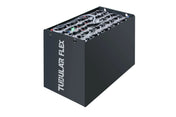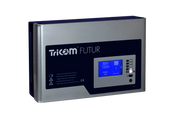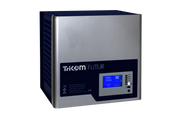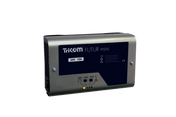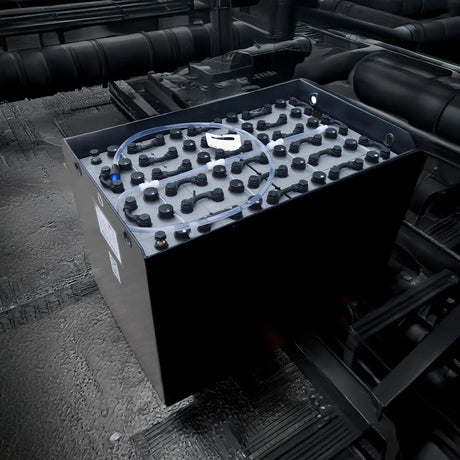In deep-freeze storage, the right forklift battery determines performance, reliability, and cost-effectiveness. Temperatures ranging from -20°C to -30°C place significant stress on the material and place high demands on battery technology. This guide shows you which battery types are suitable for use in deep-freeze storage, how they perform in subzero temperatures, and which solutions leading manufacturers recommend.
Why are deep-freeze conditions so demanding for batteries?
Extreme cold alters the chemical processes in a battery, reducing its capacity and efficiency. Reaction speed decreases, internal resistance increases, and charging processes become significantly slower. Therefore, adapted battery technology is necessary for reliable operation in deep-freeze storage facilities.
Lithium-ion batteries: The preferred solution for deep-freeze storage
Lithium-ion batteries with integrated heating are considered the optimal solution for deep-freeze operation. Modern systems feature thermal management that monitors each cell and automatically regulates the temperature as needed. This ensures performance and safety even at -30°C.
Performance in extreme temperatures
At -20°C, lithium-ion batteries lose only about 15% of their capacity and retain approximately 82% of their rated power. In comparison, the performance of conventional lithium batteries without heating drops significantly below +5°C. With integrated heating, continuous operation down to -30°C is possible.
How the battery heater works
The heater is integrated into each battery module and is activated only when needed. As soon as the temperature drops below a defined value, the heater switches on automatically, preventing capacity loss. This allows the forklift to be operated and charged even in the freezer compartment.
Operating hours without heating
- At -10°C: up to 4 hours of operation
- At -30°C: up to 2 hours of operation
Charging options in the cooling area
For best results, the charger should be placed outside the freezer at a temperature of at least +5°C. A long cable allows the forklift to be charged directly in the freezer compartment. Modern Toyota charging connectors with LED indicators display the charging status from the outside, while the cab heater can remain active.
Lead-acid batteries (PzS): Classic but sensitive technology
PzS lead-acid batteries are the traditional alternative, but they exhibit significant performance degradation at low temperatures. Capacity drops to approximately 55% of its nominal capacity at -20°C. This is due to the increased viscosity of the sulfuric acid, which significantly slows the flow of ions.
Temperature behavior and efficiency loss
At -1°C, efficiency drops to only 75%, at -18°C to 45%, and at -29°C to approximately 20%. This makes PzS batteries only partially suitable for long-term deep-freeze applications. Their optimal operating temperature is between +10°C and +30°C.
Freezing point of the electrolyte
A fully charged battery only freezes at approximately -70°C. However, a partially discharged battery can freeze at as low as -15°C and be irreparably damaged. Adequate maintenance of charge is therefore essential.
Operating recommendations according to ZVEI guidelines
- Only operate the charging station at temperatures above +10°C
- Charging time increases by 1.5–2 hours per 10 Kelvin
- Only use regulated IUI charging curves with temperature correction
- Correction factor: -0.004 V/cell per Kelvin
When used at a storage temperature of -28°C and a charging compartment temperature of +20°C, the average battery temperature is +10°C. This allows approximately 90% of the capacity to be utilized.
Important operating rules for everyday life
Water may only be refilled during the gassing phase to prevent freezing. Aquamatic systems cannot be used below 0°C. Furthermore, forklifts should not be parked in cold conditions for unnecessarily long periods to avoid condensation and icing.
Gel batteries (VRLA): Low-maintenance mid-range
Gel batteries offer better cold resistance than traditional lead-acid systems. Their temperature range is between 0°C and +40°C. They are completely maintenance-free and sealed, but with 800–1,200 charging cycles, they have a significantly shorter lifespan than lithium-ion batteries.
Comparison of battery types in deep-freeze applications
Temperature behavior
| Battery type | Optimal range | Capacity loss in cold weather | Heat tolerance |
|---|---|---|---|
| Lead-acid | +5°C to +35°C | 20–40% at 0°C; 58% capacity at -20°C | Cooling above 35°C required |
| Lithium-ion | -20°C to +55°C (with heating) | 15% loss at -20°C; 82% capacity in the freezer compartment | Stable up to 60°C (with BMS) |
| Gel (VRLA) | 0°C to +40°C | Better than lead-acid | Moderate |
economy
| criterion | Lead-acid | Lithium-ion |
|---|---|---|
| Acquisition costs | €5,000–12,000 | €17,000–25,000 |
| Loading time | 6–8 hours + 8 hours cooling | 1–4 hours |
| life | 1,000–1,500 cycles | 2,500–4,000 cycles |
| Maintenance effort | High | Very low |
| Energy efficiency | 85–90% | 95–98% |
| Total costs (5 years) | High | Low |
Condensation prevention: A crucial success factor
The greatest risk in deep-freeze operations is temperature fluctuations between the refrigerated and normal ranges. Condensation causes ice to form on vehicles and batteries, which can cause damage if repeatedly frozen. A clear operating strategy is therefore essential.
Best practices for avoiding condensation
- Leave the forklift permanently in the freezer area, including battery change
- Allow devices to dry completely after use in warm areas
- Plan your stay in the cooling area and keep it short
- Alternatively: continuous freezing operation without temperature fluctuations
Recommendations according to application scenario
Continuous use at -25°C to -30°C
Lithium-ion batteries with integrated heating from Toyota, Jungheinrich, or Linde are the first choice here. They allow charging directly in the cold storage facility, offer full power, and are completely maintenance-free.
Short-term use with charging at room temperature
Maximum-capacity lead-acid batteries are suitable for this purpose. Temperature-controlled chargers and a charging station with a minimum temperature of +10°C are required. This results in an average battery temperature of approximately +10°C.
Cooling range from 0°C to -10°C
Standard lithium-ion batteries without heating are sufficient for this temperature range. Alternatively, low-maintenance gel batteries can be used if operating times are limited.
Budget-oriented solution
Lead-acid batteries are cheaper to purchase, but incur higher operating costs due to maintenance and a shorter lifespan. Therefore, the apparent savings diminish over time.
Manufacturer solutions for deep-freeze applications
Toyota
Toyota offers Li-ion batteries with integrated heating for temperatures down to -30°C. The system automatically regulates the temperature during operation and charging.
Jungheinrich
Jungheinrich relies on configurable battery heaters for 48V systems. The batteries remain fully operational down to -28°C and are suitable for fresh food, outdoor, and freezer areas.
Linde, Still, Hyster
These manufacturers also offer special cold storage configurations with adapted lithium-ion batteries and thermal management systems for extreme conditions.
Conclusion
For continuous professional use at temperatures between -20°C and -30°C , lithium-ion batteries with integrated heating are the best choice. They combine consistent performance, fast charging times, maintenance-free operation, and low total cost over their entire service life.
Lead-acid batteries can still be used for temporary cold storage applications, but they require temperature-controlled charging management and regular maintenance. Their cost-effectiveness is only achieved for short periods of use.


